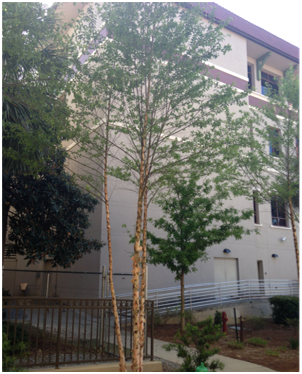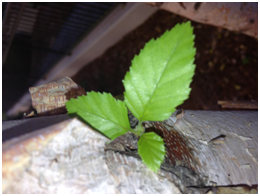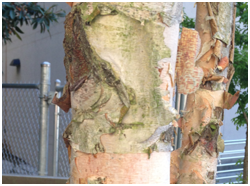River Birch
Betula nigra

(Photo by Cambrielle Sanders)
View the Location on Campus
Taxonomy (3)
Classification: Angiosperm, dicot
Family: Betulaceae
Common name: River Birch
General Information (1,2,3,4)
Region of Origin: Southeastern United States
USDA Plants Hardiness Zones: 4-9
Growth Habit: Tree
- Size: 30-50 feet tall
- Deciduous/Evergreen: Deciduous
- Flowering: February to March
- Fruiting: Spring
Diagnostic Characteristics
Leaves (2,3)
- Arrangement: Alternate
- Simple/Compound: Simple
- Shape: Ovate to elliptic
- Other: 8 centimeters long, 5.5 centimeters wide; pubescent veins on lower surface; serrate to doubly serrate

(Photo by Cambrielle Sanders)
Stem/Bark (3)
- Color: Silver, cinnamon brown (bottom layer)
- Texture: Peeling, satiny

(Photo by Cambrielle Sanders)
Flower (2,3)
- Perfect/Imperfect: Imperfect
- Color: Green or brown
- Size: 0.5-2.5 centimeters long
- Inflorescence type: Catkins
Fruit (2,3)
- Fruit type: Dry nutlet
- Size: 1-3 inches long
- Color: Tan-brown
Horticultural Information (4)
- Light: Partial shade
- Soil type: Sandy
- pH: 6.8-7.2
- Maintenance: Easy to care for
- Landscape Uses: Ornamental
Interesting Facts (1)
- The River Birch is one of the 12 Birch species that extend southward from the Artic Circle. Mud is a natural bed for the seedlings and the tree is excellent for holding stream banks and thus helping to keep erosion in check.
References
1) Arbor Day Foundation (2013, March 31). Tree Details—The Tree Guide at arborday.org. Retrieved from http://www.arborday.org/treeguide/treeDetail.cfm?id=22
2) Dirr, M. (1998). Manual of Woody Landscape Plants. (5th ed., pp. 208-211). Champaign, Illinois: Stipes Publishing L.L.C.
2) Radford, A. E., Ahles, H. E., & Bell, C. R. (1968). Manual of the vascular flora of the Carolinas. Chapel Hill: University of North Carolina Press.
3) TWC Staff (2012, October 15). Betula nigra (River birch) | NPIN. Retrieved from http://www.wildflower.org/plants/result.php?id_plant=BENI
Edited by Jessica Bartek
Department of Biology
-
Room 2035, 2nd Floor
Bailey Science Building -
Mailing Address
1500 N. Patterson St.
Valdosta, GA 31698 - Phone: 229.333.5759
- Fax: 229.245.6585
Monday - Thursday
8:00AM until 5:30PM
Friday
8:00AM until 3:00PM
Saturday - Sunday
Office Closed